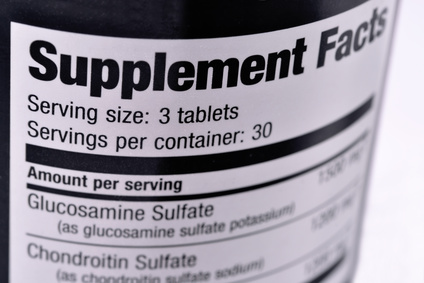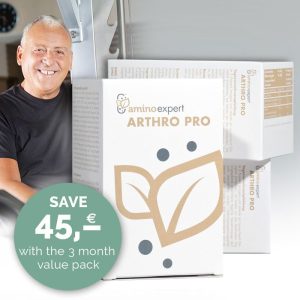Contents
- 1 Glucosamine
- 1.1 What is Glucosamine?
- 1.2 Glucosamine for Pain Relief and Cartilage Development
- 1.3 Studies on Glucosamine
- 1.4 Effectiveness of Glucosamine Sulfate in Combination with Other Substances
- 1.5 Glucosamine in Osteoarthritis in Horses
- 1.6 Joint and Cartilage Support Combination Products: For Complete Support!
- 1.7 Bibliography:
Glucosamine
Glucosamine is a naturally occurring substance (amino sugar) in the joints. Multiple studies have shown that when it is consumed for a minimum of two to six months, it seems to have anti-inflammatory and cartilage-building effects.
The effects are significantly improved when glucosamine is combined with chondroitin and omega-3 fatty acids. In addition, several other other natural micro nutrient remedies such as pine bark extract and vitamins can help the body fight inflammation and improve the metabolism of cartilage.
Generally, glucosamine as well as other natural micro nutrient joint foods have no side effects. They can and should be taken over a long period of time. The amino sugar is generally considered an essential element of a natural complimentary food therapy for the treatment of osteoarthritis and arthritis.
Therefore many orthopaedists recommend taking glucosamine and other nutrients:
TIP: Combine glucosamine with chondroitin and omega-3 fatty acids from fish oil (DHA and EPA). Omega-3 fish oil does not only help to protect your joints against inflammation, but it helps you improve the health of your blood vessels and cholesterol levels at the same time!
Joint and Cartilage Support Combination Products: For Complete Support!
A chain is only as strong as its weakest link. This applies also to the processes of maintaining cartilage and combatting inflammation. Cartilage, ligaments and bones need a multitude of vitamins, minerals and amino acids for tissue generation and to counteract inflammation.
There are many simple glucosamine supplements on the market. Optimised joint food supplements with sensibly combined micro nutriernts however are few and far in between.
Patients with osteoarthritis: keep moving and eat right to support your joint health!
Firstly, natural remedies tend to be complimentary to a holistic approach of treating arthritis. Secondly, it is important to gently and continuously keep your joints moving, whilst taking care to avoid high impact loads on joints.
The third and final important element of avoiding wear and tear of joints is to avoid being overweight and ensure that you eat properly. This includes avoiding foods, which promote inflammation and instead focus on foods, which combat inflammation.
Bibliography:
- Selvan et al. 2012. A Clinical Study on Glucosamine Sulfate on it’s own, compared to combining it with NSAIDs in Mild to Moderate Knee Osteoarthritis. Scientific World Journal: 902676; doi: 10.1100/2012/902676 ↩
- Clegg, D.O. et al.: “Glucosamine, chondroitin sulfate, and the two in combination for painful knee osteoarthritis.” NEJM, 2006, 354, 795-808 ↩
- Henrotin et al. 2012. Is there any scientific evidence for the use of glucosamine in the management of human osteoarthritis? Arthritis Research Therapy 14(1), 201 ↩
- Gruenwald et al. 2009. Effect of glucosamine sulfate with or without omega-3 fatty acids in patients with osteoarthritis. Advances in Therapy 26(9), 858-871; Haflah et al. 2009. Palm vitamin E and glucosamine sulphate in the treatment of osteoarthritis of the knee. Saudi Medical Journal 30(11), 1432-1438 ↩
- Chan et al. 2007. Effects of glucosamine and chondroitin sulfate on bovine cartilage explants under long-term culture conditions. American Journal of Veterinary Research 68:709–715. doi: 10.2460/ajvr.68.7.709 ↩
- Burdett & McNeil. 2012. Difficulties with assessing the benefit of glucosamine sulfate as a treatment for osteoarthritis. Int J Evid Based Healthc 10(3), 222-6; doi: 10.1111/j.1744-1609.2012.00279.x ↩
- Meulyzer et al. 2008. Comparison of pharmacokinetics of glucosamine and synovial fluid levels following administration of glucosamine sulfate or glucosamine hydrochloride. Osteoarthritis Cartilage 16(9), 973-9; doi: 10.1016/j.joca.2008.01.006 ↩
- Park et al. 2013. Nonsteroidal anti-inflammatory drugs (NSAID) sparing effects of glucosamine hydrochloride through N-gycosylation inhibition; strategy to rescue stomach from NSAID damage. J Physiol Pharmacol 64(2), 157-165 ↩







